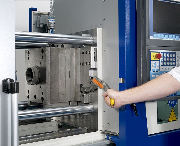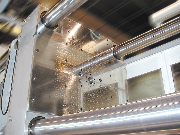 Fast and simple mould changing is vital to the efficient operation of many injection moulding installations. After operators have reduced mould changeover times by, for example, using quick release mould connectors, installing multi coupling plates and automatic mould transfer mechanisms, frequently with pre-heating stations, the final step to be considered should be investment in a quick mould clamping system.
Fast and simple mould changing is vital to the efficient operation of many injection moulding installations. After operators have reduced mould changeover times by, for example, using quick release mould connectors, installing multi coupling plates and automatic mould transfer mechanisms, frequently with pre-heating stations, the final step to be considered should be investment in a quick mould clamping system.
There are three main technologies used for mould clamping, manual (mechanical), hydraulic and magnetic; each one having a number of design features that makes them more suited to a specific range of applications. Stäubli, the specialists in mould connection and clamping systems, manufacture systems of each type making them uniquely able to advice on selection of the appropriate system for any application.
Mechanical Systems
 Mechanical systems, where the mould is held in position by a manual bayonet mechanism, are only suitable for injection moulding machines up to 250 tonne capacity. These are simple low cost systems that are relatively easy to install. Nearly all injection moulding machines can be equipped with, for example, the Stäubli QMC 106 clamping system, which requires no electric or hydraulic connections.
Mechanical systems, where the mould is held in position by a manual bayonet mechanism, are only suitable for injection moulding machines up to 250 tonne capacity. These are simple low cost systems that are relatively easy to install. Nearly all injection moulding machines can be equipped with, for example, the Stäubli QMC 106 clamping system, which requires no electric or hydraulic connections.
Existing moulds will require modification; a recess has to be machined into the mould to accept a centring ring in place of the normal register ring.
This may cause complications, particularly where the mould is the property of the customer. The bayonet system, lever operated by a removable handle, ensures secure mould clamping by simple and positive safety locking onto the centring ring. The complete working surface of the platens remains available for use and any shape of mould can be accommodated.
For larger moulding machines, above 250 tonne capacity, manual mechanical systems are not suitable being unable to withstand opening forces (assumed as 10% of machine capacity) of much above 25 tonne. For these applications the choice is between hydraulic or magnetic clamping systems.
Hydraulic Systems
Hydraulic systems are suitable for any size of injection moulding machine up to the highest capacity. Single acting or double acting hydraulic clamps, conforming to EUROMAP requirements, are available for the automatic clamping of moulds on existing and new machines. The clamps made from hardened steel, operate on a steel backplate securely bolted to each mould.
Moulds require more modification than in the manual bayonet system and the backplate dimensions are critical to ensure clamping effectiveness. Any variation in tolerance on backplate thickness is taken up by the clamps.
The backplates have to be left permanently attached to each mould, adding significantly to the overall cost of this type of clamping system.
Proximity sensors monitor if the mould is in the ‘clamped’ or ‘unclamped’ condition.
The hydraulic systems installed on the moulding machine may not be adequate to operate the mould clamping system and frequently upgrading is required prior to installation.
Injection moulding machine manufacturers are increasingly fitting clamping systems to their machines prior to installation. Which system is applied often being left to their customers to select to match the particular applications involved. Hydraulic clamping can offer the lowest cost solution on simple installations, however where machine systems require upgrading and new, common sized, backplates are needed costs can increase significantly.
Magnetic Systems
Magnetic systems are suitable for all sizes of moulding machine. The key advantage of magnetic systems is that no modification to moulds is required and the use of backplates is eliminated. The system will readily accept any shape of mould. Magnetic systems are quick to install, fast in operation and virtually maintenance free, having no moving parts. They are frequently the lowest cost option for a wide range of quick clamping applications.
Safety is always a concern on magnetic clamping systems in case the forces on the mould overcome the magnetic force holding the mould in place.
The latest mould clamping system, Stäubli’s QMC 122, features patented new technology in the form of adaptive clamping force systems, combined with active safety management, to provide total security, fully integrated with the moulding press.
Magnetic clamping is suitable for use with injection moulding machines without modification and is fully compatible with the Euromap 70.0 or 70.1 interfaces; SPI and JIC are additional options. It is easy to use and provides new levels of safety, reliability and performance. The magnetic platens incorporate independent circular pole modules, 60mm diameter on a slim plate of 52mm, poles are concentrated around the centre of the plate to suit a wide range of mould sizes including those with thin back plates (<13mm).
The technology actively manages and secures the clamping operation. Software guides the operator through an interactive safety checklist prior to clamping/unclamping. The system calculates and compares the clamping force required with the opening force, nozzle force and ejection force of the moulding machine and detects any decrease in the original clamping force. Each mould is stored with an identification number giving quick recall of the mould parameters and original clamping force.
The system also integrates the safety information coming from the moulding press prior to clamping, such as that the injection moulding machine is in ‘machine change mode’ and if the door is open or closed. The system energises quickly – less than one second for 80 magnetic modules – and only requires electrical power for the clamping/unclamping operation. The mould is secured on the machine platen by permanent magnets and will not be affected by any power loss.
Optimal clamping force is provided through a high concentration of magnetic poles. The honeycomb type construction provides significant advantages; it ensures high stiffness, strength and durability. The innovative design also makes maintenance much easier. If a magnetic pole module is damaged e.g. by collision with a mould, it can easily be replaced on site – minimising machine downtime.
Permanent monitoring of magnetic clamping systems is important. The system will alert operators to any drop in the clamping force and indicates when a mould can still be safely clamped but will require maintenance post production as well as moulds where the minimum clamping force cannot be achieved and attention is needed immediately to the mould back plate before production. The injection moulding machine will be shut down if the system detects any mould movement or temperature over-run. A data log records the last 700 operations made.
The Stäubli QMC 122 magnetic clamping system offers a high integrity and effective quick mould change system, improving on existing technology, with easier and quicker operation combined with the reassurance of comprehensive active safety monitoring systems.
Stäubli is an international family owned group founded over 100 years ago in Switzerland employing 4200 world-wide. The Couplings Division manufacturing facilities are located in France, Germany, Italy, Switzerland, USA and China with offices across Europe, North and South America and the Far East; the UK base is in Telford.
Stäubli (UK) Ltd.
Stäubli House
Hadley Park East
Telford
TF1 6QJ
E-mail: connectors.uk@staubli.com
Website: www.staubli.com
